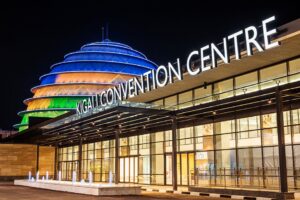1-Day Kigali City Tour
Experience Rwanda's culture, history, and main sights in a single-day safari to Kigali, the capital of Rwanda, "the land of a thousand hills."
Kigali is a pleasant city to visit any time of year thanks to its pleasant climate and pleasant topography (hills and other scenic features). Jurapark and Mount Kigali offer the best panoramas of the city. All the hills, cities, slums, and neighborhoods may be seen from these vantage points.
On our one-day tour, you’ll learn about the country’s culture, history, and development since the end of the genocide in 1994. Include a day in Kigali on your Rwanda safari alongside activities like gorilla trekking in Volcanoes National Park, cultural tours, a game drive in Akagera National Park, discovering the spectacular Lake Kivu, biking along the Congo Nile trail, and chimpanzee trekking in Nyungwe National Park. To see as much as we can, we’ll rent a car even though you can easily get around Kigali on foot or on a bike. Your preferences, hobbies, and finances will determine how many locations you can afford to see. As long as they are located in Kigali, you are welcome to request to skip some attractions or to be transported to locations that are not included in the itinerary.
Make a mental note, and then have some breakfast. Pickup is available from any location in Kigali, including hotels and private homes. Both half-day and full-day tours are available upon request.
Please be aware that the itinerary may change depending on when you begin your tour or where you are picked up in Kigali. Read up on the things to do in Rwanda and the cultural tourism sites in Rwanda before embarking on the morning 1 Day tour of Kigali.
You should begin your explorations at Mount Kigali. This hill is the highest in Kigali, yet it is not a mountain. Mount Kigali is the city’s highest peak, and from there you can see all of Kigali and the surrounding hills, countryside, and cityscape. There’s a restaurant and a tour company offering horseback rides atop the hill.
The Museum of Natural History: Formerly the home of Dr. Richard Kandt, the Natural History Museum is now a museum dedicated to the study of history. The city of Kigali was given its name by Kandt. Between Kigali and Jali Mountains is where you’ll find the Museum. Known as the “father of contemporary architecture in Rwanda,” Kandt was a renowned German explorer. If you want to understand more about colonial Kigali and Rwanda, the Natural History Museum is the best venue to do it. In Rwanda, it predates any other modern structure by decades. You can find out that Kigali was founded in 1907 as a colonial outpost by visiting the museum and speaking with the local guides.
Kigali Genocide
 Monument to the Victims of the Genocide in Kigali Over 800,000 people perished in the genocide that took place in 1994, and memorials like this one have been constructed all over the country in their honor. Approximately 2500 persons are interred at this genocide memorial monument in Gisozi. There are three main exhibits to view at the Site; one is a tribute to the innocent children who were killed in the 1994 genocide, while the other two exhibits focus on basic facts regarding the genocide. The final display looks at genocides from around the world. While here, you can watch documentaries, and movies, or listen to personal presentations that detail the events leading up to, during, and after the genocide. Even though it may be difficult to see, learning about the atrocities of genocide is crucial for ensuring that such atrocities never happen again.
Monument to the Victims of the Genocide in Kigali Over 800,000 people perished in the genocide that took place in 1994, and memorials like this one have been constructed all over the country in their honor. Approximately 2500 persons are interred at this genocide memorial monument in Gisozi. There are three main exhibits to view at the Site; one is a tribute to the innocent children who were killed in the 1994 genocide, while the other two exhibits focus on basic facts regarding the genocide. The final display looks at genocides from around the world. While here, you can watch documentaries, and movies, or listen to personal presentations that detail the events leading up to, during, and after the genocide. Even though it may be difficult to see, learning about the atrocities of genocide is crucial for ensuring that such atrocities never happen again.
After touring the Kigali Genocide Memorial, your driver/guide will take you to some of the city’s finest craft centers, where you may pick up some unique keepsakes to remind you of your stay in Kigali. The Inema Art Center, the Ivuka Arts studios, and Caplaki are the best places to find skilled artisans. The local community, and the women in particular, can benefit from tourists purchasing gifts at places like the Caplaki Handcrafts Co-operatives.

The largest gatherings in Kigali, including conventions, seminars, and trade shows, take place in the city’s convention center. The facility can house up to 2,500 people and is located in close proximity to Kigali International Airport. There is also a five-star hotel in the complex, the Radisson blue hotel, which has 292 rooms and is considered one of the best in the world. The Kigali Convention Centre also houses a variety of shops, arcades, restaurants, and offices. You can go there to experience a cutting-edge retail center, stay in comfortable lodgings, and mix with Rwanda’s upper class.
The Presidential Museum. In the past, this Museum served as the official residence of Rwanda’s two presidents. There are significant links between the Rwandan Genocide of 1994 and the Presidential Museum. One day, President Habyarimana’s plane had to make an emergency landing, and it flew right into the grounds of the presidential palace. The life of President Habyarimana is the focus of much of the tour. In April 1994, the presidential jet was shot down, resulting in the murder of Habyarimana and the beginning of a genocide that had been planned for some time but never carried out. After visiting this museum, you will gain insight into the events preceding and following the Rwandan genocide.
Visiting the Kimironko Market is a great way to get a feel for local life and customs. Shoppers in Kigali can choose from a wide variety of local marketplaces, each stocking goods and commodities produced or grown within the country. Among the many popular markets in Kimironko, you may find a wide variety of fresh produce, including spices, herbs, vegetables, fruits, salt, meat, and fish. People selling paintings, sculptures, and other works of art will also be present.
Kigali’s Nyamata Church is one of numerous memorials to the victims of the 1994 genocide that can be located across the country. Nearly fifty thousand people were slaughtered at this chapel. They hoped that by hiding in the church, the Interahamwe would leave them alone. A deadly trap, the church was targeted by the murderers who killed everyone inside. Skulls, bones, bloodstained clothing, national identity cards, and machetes used by the Interahamwe can still be seen today. Near the church is a mass grave where most of the deceased were laid to rest.
The Hotel des Mille Collines, sometimes known as the Hotel Rwanda, was an important location during the Rwandan genocide in 1994. The hotel’s administration sheltered more than a thousand guests inside the building while the outside world descended into mayhem. Both the international and regional fare served at the hotel are top-notch. Buffets are available every day, and guests may chow down on regional specialties like ibijumba and amateke. The chauffeur may suggest stopping by this opulent hotel for lunch and a brief history lesson on its part in the holocaust.
The driver can take you to Lake Nyarutarama to meet individuals from the surrounding neighborhoods if you’re interested in mingling with them. This lake is popular among city dwellers for swimming and fishing. The African Hobby, Bat Hawk, Cinnamon-chested Bee-eater, Cisticolas, Little Bee-eater, Red-backed Shrike, Red-chested Cuckoo, Spot-flanked Barbet, Squacco Heron, Sunbirds, Swamp Flycatcher, Yellow-billed Duck, and many more may all be seen in Lake Nyarutarama, one of Rwanda’s top birding spots. you can also have a 1-day tour to volcanoes national park to enjoy gorilla trekking experience, but its normally done to visitors near the park who can manage to travel to the park in time to find the trekking briefing at 7:00 am.